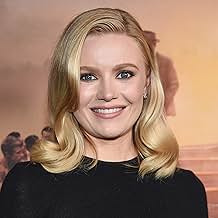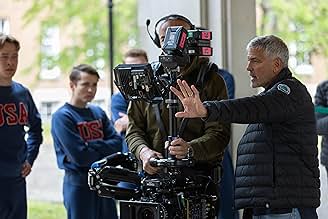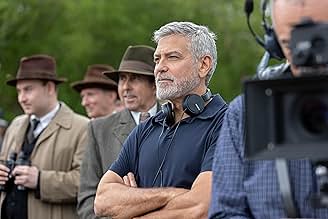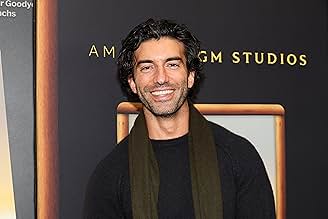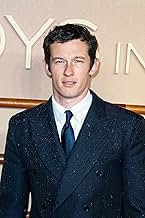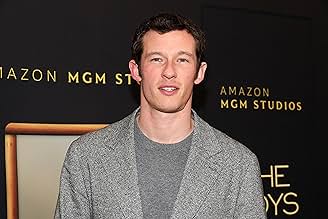Historia ambientada en los años 30 y centrada en el equipo de remo de la Universidad de Washington, desde sus comienzos en la era de la Depresión hasta ganar el oro en los Juegos Olímpicos d... Leer todoHistoria ambientada en los años 30 y centrada en el equipo de remo de la Universidad de Washington, desde sus comienzos en la era de la Depresión hasta ganar el oro en los Juegos Olímpicos de Berlín de 1936.Historia ambientada en los años 30 y centrada en el equipo de remo de la Universidad de Washington, desde sus comienzos en la era de la Depresión hasta ganar el oro en los Juegos Olímpicos de Berlín de 1936.
- Dirección
- Guionistas
- Elenco
- Premios
- 2 premios ganados y 6 nominaciones en total
Tom Varey
- Johnny White
- (as Thomas Stephen Varey)
- Dirección
- Guionistas
- Todo el elenco y el equipo
- Producción, taquilla y más en IMDbPro
Opiniones destacadas
We waited so long for this movie to be made, ever since Daniel James Brown wrote the story. A serendipitous set of events led to the story even being recorded, as Judy Rantz Willman just happened to have Daniel James Brown as a neighbor, and eventually persuaded Brown to visit her father, who was in hospice care. What he thought was a social visit, she saw as a book about to be written. His initial skepticism evaporated quickly, when Joe began sharing his story. In Joe's remaining couple of months of life, Brown met with Rantz several times to begin creating the outline for the book. He then met with the families of the other crew members, followed by two years of further research, aided by Judy Rantz. The eight were amazing people, accustomed to hardship and personal challenges. For example, when Don Hume's family moved from Anacortes to Olympia, Don tossed his belongings into a rowboat and paddled down Puget Sound to his new home, roughly 100 miles away. Look at a map! A multiple-sport letterman in high school, he had also placed third in a state pianist's competition. And Joe Rantz was such a standout athlete in gymnastics at Roosevelt High School, that Coach Ulbrickson already had his eye on him then. So, what did we miss in the movie? Joe's difficult pre-college life is mostly absent, and worth the read by itself. We also miss Joe's wanderings around Berlin, where he witnesses Germany's horrific treatment of its Jewish population, under its totalitarian leader. Like nearly everything from Hollywood, a bit of romance is thrown in to add spice, but the story shines, throughout the picture. Here and there a bit of drama is added for effect, but personalities presented by the actors conform closely with who they represented. George Pocock really was the sage he seemed in the movie. Don Hume comes across as a bit socially awkward in the movie. A good friend met him several years ago where she worked, and described him as, uh, gruff. The fearless audacity of the team comes through in a story told only in the book. Before sailing to Germany for the Olympics, the team decides to drop in, unannounced, on Franklin Roosevelt at his home. Although they didn't find the president at home, they did spend the evening there. The story behind this movie is too remarkably wonderful to be fiction. See the movie, but by all means read the book!
As a former rower, I'm glad I saw this movie. There's a certain mental stamina, in addition to physical strength, required to row a boat fast and in sync with others that not many people realize. This movie definitely made an effort to capture that, but it didn't always quite hit the mark. The creators definitely felt a lot of respect for the sport, but I don't think they would have quite sold it to me if I didn't feel the same.
The script was the biggest weak point for this movie. It was very uninspired, totally predictable. The dialogue was very wooden, and the characters were almost entirely flat. Joel Edgerton sold me on his character as a very guarded, stern-faced coach with a heart of gold, but the rest of the cast was pretty unremarkable. It's not all their fault though, most of them get very little to work with. The last scene actually made me roll my eyes, it was so cheesy and frankly amateur.
The music was a interesting. I really didn't like the score in the opening and first few scenes, but it really got me at the story's pivotal moments. That should be what counts I guess.
I did really enjoy the set though; the costumes to the production design were excellent and really painted a picture of an America that has been suffering from 5 years of the Depression that are starting to claw their way through hope and resilience to a bit of a better place.
All and all, this was a really warm feel-good story, just not one of the best movies ever made. I'm glad I saw it, but will probably never watch it again.
The script was the biggest weak point for this movie. It was very uninspired, totally predictable. The dialogue was very wooden, and the characters were almost entirely flat. Joel Edgerton sold me on his character as a very guarded, stern-faced coach with a heart of gold, but the rest of the cast was pretty unremarkable. It's not all their fault though, most of them get very little to work with. The last scene actually made me roll my eyes, it was so cheesy and frankly amateur.
The music was a interesting. I really didn't like the score in the opening and first few scenes, but it really got me at the story's pivotal moments. That should be what counts I guess.
I did really enjoy the set though; the costumes to the production design were excellent and really painted a picture of an America that has been suffering from 5 years of the Depression that are starting to claw their way through hope and resilience to a bit of a better place.
All and all, this was a really warm feel-good story, just not one of the best movies ever made. I'm glad I saw it, but will probably never watch it again.
Boys in the Boat is maybe my favorite nonfiction book of all time. The story of Joe Rantz is inspiring tragic and incredibly easy to root.
The boys in the boat movie captures the beauty of rowing and team work, but it only begins to scratch the surface of the depth of these real life characters.
The biggest flaw in this movie is the writing and at times the dialogue. The writers boil down the tragedies of Joe Rantz and his teammates to simplistic and generic back stories when it would have lead to a more emotional movie to focus on how little these people were given in there life's and how much they were able to accomplish.
While it was still enjoyable and inspiring to watch this classic story, with the material that they had, they should have created a much more emotional and factual film.
I would recommend this movie to anyone but I would highly recommend people read the book.
The boys in the boat movie captures the beauty of rowing and team work, but it only begins to scratch the surface of the depth of these real life characters.
The biggest flaw in this movie is the writing and at times the dialogue. The writers boil down the tragedies of Joe Rantz and his teammates to simplistic and generic back stories when it would have lead to a more emotional movie to focus on how little these people were given in there life's and how much they were able to accomplish.
While it was still enjoyable and inspiring to watch this classic story, with the material that they had, they should have created a much more emotional and factual film.
I would recommend this movie to anyone but I would highly recommend people read the book.
... Merrily, merrily, merrily,
Life is but a dream ...
A huge bestseller when it was published in 2013, Daniel James Brown's "The Boys in the Boat" was a big hit in my circle of friends. The kind of book that gets recommended, if not passed around, pal to pal.
Set in the '30s it was the true story of the University of Washington junior varsity rowing team who not only gunned down the storied, legacy crews of California and Ivy League colleges, but went on to the 1936 Olympics in Adolf Hitler's Berlin. It was an adrenalized page turner, a movie waiting to happen.
Now that it's getting to the screen, it helps to have George Clooney in the director's chair. Although he stays offscreen, the double-Oscar-winning actor, producer and director is the biggest name on the project.
It's his face - generally recognized as one of the coolest guys on the planet - in many of the production stills and the "for your consideration" ads targeted at industry voters this awards season. George and co-producer Grant Heslov also took part in a recent Zoom press conference for the film along with cast members Joel Edgerton, who stars as taciturn coach Al Ulbrickson; Callum Turner, who plays team member Joe Rantz; and Hadley Robinson, who lights up the screen as Joe's sweetheart, Joyce.
Opening in theaters Christmas Day, it's a feel-good throwback to old-fashioned moviemaking.
Taking place during the Great Depression, the scrappy kids at their oars offered glimpses of optimism and hope, rare commodities in those tough times. Rowing was a popular spectator sport in that pre-ESPN era with spectators lining river banks and in some cases following the action in train cars on the shore keeping pace with the sleek 8-man wooden shells slicing through the water.
Not just an incredibly demanding sport, rowing was a culture, too. The rowing world was made of wood - not just the glossy racing shells, but also their big-doored, high-ceilinged boat houses. You can almost smell the resins and varnish coming from the boathouse surrounded by lush forest on the Seattle campus.
As the team keeps achieving more success, the gorgeous historically recreated settings move, first to colleges on the East Coast before heading for swastika-adorned Germany. Legendary speedster Jesse Owens was another member of the U. S. Olympic team that year. During the press conference Clooney acknowledged borrowing camera angles from Hitler's propagandist Leni Riefenstahl for the climactic Olympic rowing scenes.
"We like to use Nazis whenever we can for filming," he joked.
The mood was light during the Zoom press conference, now that the film was in the can and the cast's arduous training was long past.
London-born actor Turner, whose Joe Rantz is as close as the eight-man team can get to having a hero, acknowledged that he hadn't had any previous rowing experience.
"None of us had actually. And we turn up in February, and we get on the river. And it's snowing. And we're all in the tight shorts and freezing cold and have no skill at being in the boat. And after about three weeks, George and Grant come down to have a look and check in on us. We weren't in a good place. And I could see the pain behind the smile on George's face." "That wasn't pain. That was fear," corrected Heslov.
The boys on the real team hadn't had any experience, either. For Joe and several teammates, making the team - beating the scores of hopefuls for the eight seats (plus the coxswain) - meant getting room and board at the university.
Unlike Ivy Leaguers born to the sport, the junior Huskies were rough hewn. "They were lumberjacks," said Clooney. They came together as a team "out of necessity, out of hunger, out of having nothing else." The actors trained together for five months. Unlike their competitors in the film in new fiberglass shells, their boat, the Huskie Clipper, was made of wood like the original. Beyond just acting, there was a sense of athletic accomplishment for Turner and his teammates.
"The hardest part about rowing is that you all have to be in complete unison," said the actor. "There's no, like, hiding. And if one person is out by a millimeter, the boat suffers." For his part, Clooney faced a different set of challenges.
"The oars are, you know, 15 feet long. And then the boats are 40-some feet long. So, you can't get close to the boats with the camera. And you can't get side by side or ahead of the boats with your camera boat, 'cause you'll capsize the boat. So, we had to come up with a design to get in tight enough to make it exciting. Meaning, we're on an 80-foot arm on the boat with a 300-millimeter lens, 200-millimeter lens, down low, getting wet, trying to hold focus while you're doing that. So, there was a ton of, like, math to try to make those things exciting." On top of that, neither Joe Rantz or Coach Ulbrickson were especially loquacious. They were men of action rather than words. On the printed page this is no big deal. On the big screen it can be. Hadley Robinson's feistiness along with her beauty, and Courtney Henggeler's portrayal of the coach's wife, Hazel, go a long way to humanizing their male partners.
In a key scene, Joe and Joyce share what Clooney called "a 1940s movie kiss" - in a train station, no less. In a way, "The Boys in the Boat" itself is a 1940s movie. It's beautiful to look at, it wears its heart on its sleeve. It comes from an era when wholesome was cool. Standing up and cheering was nothing to be embarrassed by.
But the psychological reserve of its characters played better on the page than they do on the screen.
Despite Clooney's assured direction and the unbreakable spirit of the cast, neither the predictable script nor the soft sentiments of Alexandre Desplat musical score produce the irrepressible "Chariots of Fire" sorts of emotions that spell the difference between good sports movies and great ones.
A huge bestseller when it was published in 2013, Daniel James Brown's "The Boys in the Boat" was a big hit in my circle of friends. The kind of book that gets recommended, if not passed around, pal to pal.
Set in the '30s it was the true story of the University of Washington junior varsity rowing team who not only gunned down the storied, legacy crews of California and Ivy League colleges, but went on to the 1936 Olympics in Adolf Hitler's Berlin. It was an adrenalized page turner, a movie waiting to happen.
Now that it's getting to the screen, it helps to have George Clooney in the director's chair. Although he stays offscreen, the double-Oscar-winning actor, producer and director is the biggest name on the project.
It's his face - generally recognized as one of the coolest guys on the planet - in many of the production stills and the "for your consideration" ads targeted at industry voters this awards season. George and co-producer Grant Heslov also took part in a recent Zoom press conference for the film along with cast members Joel Edgerton, who stars as taciturn coach Al Ulbrickson; Callum Turner, who plays team member Joe Rantz; and Hadley Robinson, who lights up the screen as Joe's sweetheart, Joyce.
Opening in theaters Christmas Day, it's a feel-good throwback to old-fashioned moviemaking.
Taking place during the Great Depression, the scrappy kids at their oars offered glimpses of optimism and hope, rare commodities in those tough times. Rowing was a popular spectator sport in that pre-ESPN era with spectators lining river banks and in some cases following the action in train cars on the shore keeping pace with the sleek 8-man wooden shells slicing through the water.
Not just an incredibly demanding sport, rowing was a culture, too. The rowing world was made of wood - not just the glossy racing shells, but also their big-doored, high-ceilinged boat houses. You can almost smell the resins and varnish coming from the boathouse surrounded by lush forest on the Seattle campus.
As the team keeps achieving more success, the gorgeous historically recreated settings move, first to colleges on the East Coast before heading for swastika-adorned Germany. Legendary speedster Jesse Owens was another member of the U. S. Olympic team that year. During the press conference Clooney acknowledged borrowing camera angles from Hitler's propagandist Leni Riefenstahl for the climactic Olympic rowing scenes.
"We like to use Nazis whenever we can for filming," he joked.
The mood was light during the Zoom press conference, now that the film was in the can and the cast's arduous training was long past.
London-born actor Turner, whose Joe Rantz is as close as the eight-man team can get to having a hero, acknowledged that he hadn't had any previous rowing experience.
"None of us had actually. And we turn up in February, and we get on the river. And it's snowing. And we're all in the tight shorts and freezing cold and have no skill at being in the boat. And after about three weeks, George and Grant come down to have a look and check in on us. We weren't in a good place. And I could see the pain behind the smile on George's face." "That wasn't pain. That was fear," corrected Heslov.
The boys on the real team hadn't had any experience, either. For Joe and several teammates, making the team - beating the scores of hopefuls for the eight seats (plus the coxswain) - meant getting room and board at the university.
Unlike Ivy Leaguers born to the sport, the junior Huskies were rough hewn. "They were lumberjacks," said Clooney. They came together as a team "out of necessity, out of hunger, out of having nothing else." The actors trained together for five months. Unlike their competitors in the film in new fiberglass shells, their boat, the Huskie Clipper, was made of wood like the original. Beyond just acting, there was a sense of athletic accomplishment for Turner and his teammates.
"The hardest part about rowing is that you all have to be in complete unison," said the actor. "There's no, like, hiding. And if one person is out by a millimeter, the boat suffers." For his part, Clooney faced a different set of challenges.
"The oars are, you know, 15 feet long. And then the boats are 40-some feet long. So, you can't get close to the boats with the camera. And you can't get side by side or ahead of the boats with your camera boat, 'cause you'll capsize the boat. So, we had to come up with a design to get in tight enough to make it exciting. Meaning, we're on an 80-foot arm on the boat with a 300-millimeter lens, 200-millimeter lens, down low, getting wet, trying to hold focus while you're doing that. So, there was a ton of, like, math to try to make those things exciting." On top of that, neither Joe Rantz or Coach Ulbrickson were especially loquacious. They were men of action rather than words. On the printed page this is no big deal. On the big screen it can be. Hadley Robinson's feistiness along with her beauty, and Courtney Henggeler's portrayal of the coach's wife, Hazel, go a long way to humanizing their male partners.
In a key scene, Joe and Joyce share what Clooney called "a 1940s movie kiss" - in a train station, no less. In a way, "The Boys in the Boat" itself is a 1940s movie. It's beautiful to look at, it wears its heart on its sleeve. It comes from an era when wholesome was cool. Standing up and cheering was nothing to be embarrassed by.
But the psychological reserve of its characters played better on the page than they do on the screen.
Despite Clooney's assured direction and the unbreakable spirit of the cast, neither the predictable script nor the soft sentiments of Alexandre Desplat musical score produce the irrepressible "Chariots of Fire" sorts of emotions that spell the difference between good sports movies and great ones.
Very few people know this story and how incredible this was and honestly the movie didnt even touch on it enough, i know its two hours and what can they do.
Its a family movie that adults will also like the acting is perfect.
Have to give it to Clooney for doing this he had to know this wasn't going to be a huge money maker but did it anyway.
Been waiting for this since i read the fantastic book wondering if someone would pick it up. We need to pay to see these if we want them to be made in the future.
Would have like to have the accomplishments of the rowers show in the credits like the book explained, these were all very successful people, doctors, lawyers and such.
Its a family movie that adults will also like the acting is perfect.
Have to give it to Clooney for doing this he had to know this wasn't going to be a huge money maker but did it anyway.
Been waiting for this since i read the fantastic book wondering if someone would pick it up. We need to pay to see these if we want them to be made in the future.
Would have like to have the accomplishments of the rowers show in the credits like the book explained, these were all very successful people, doctors, lawyers and such.
¿Sabías que…?
- TriviaIn a scene during the Olympics, there is mention of Ran Laurie in the British boat. Ran Laurie was the father of actor Hugh Laurie.
- ErroresThe newsreel in the movie says Jesse Owens is from the University of Ohio. While there is an Ohio University in Athens, Ohio, he was actually a student at The Ohio State University --- so named in 1878, well before 1936.
- Citas
German Oarsman: Heil Hitler!
Johnny White: Remember the Alamo!
- ConexionesFeatured in Jimmy Kimmel Live!: George Clooney/Kumail Nanjani/Lenny Kravitz (2023)
- Bandas sonorasUntil Life Turns Your Way Again
Written and Performed by Ian James Donaldson
Courtesy of Black Toast Music
Selecciones populares
Inicia sesión para calificar y agrega a la lista de videos para obtener recomendaciones personalizadas
- How long is The Boys in the Boat?Con tecnología de Alexa
- What locomotive pulls the spectator train along the Hudson River?
Detalles
- Fecha de lanzamiento
- País de origen
- Sitio oficial
- Idiomas
- También se conoce como
- The Boys in the Boat
- Locaciones de filmación
- Cleveland Lakes Nature Reserve, Ashton Keynes, Swindon, Wiltshire, Inglaterra, Reino Unido(University of Washington Boathouse, Berlin Olympics)
- Productoras
- Ver más créditos de la compañía en IMDbPro
Taquilla
- Presupuesto
- USD 40,000,000 (estimado)
- Total en EE. UU. y Canadá
- USD 52,641,306
- Fin de semana de estreno en EE. UU. y Canadá
- USD 8,400,548
- 31 dic 2023
- Total a nivel mundial
- USD 55,501,365
- Tiempo de ejecución2 horas 3 minutos
- Color
- Mezcla de sonido
- Relación de aspecto
- 2.39 : 1
Contribuir a esta página
Sugiere una edición o agrega el contenido que falta

Principales brechas de datos
What is the Canadian French language plot outline for The boys in the boat (2023)?
Responda






